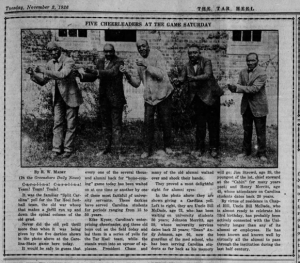We are pleased to present this guest post from UNC-Chapel Hill student Autumn Linford. Autumn is a Park Fellow in the Hussman School of Journalism and Media.
Aros Coke Cecil’s photographs could be the work of any UNC undergrad of any era. Playing sports, the Old Well, friends goofing around, socializing with pretty co-eds: the images in Cecil’s 1917-1918 album wouldn’t seem out of place on a student’s Instagram page today. There are photos of students studying, photos of students procrastinating, and even one of Cecil and a friend clowning around with a classroom skeleton (see figure 1).
There is only one photo in the album that stands out. A young man, college-aged, stands in a dorm room holding a bucket and broom (see figure 2) Pennants and framed pictures are tacked to the wall behind him. It isn’t the scene that sets this photograph apart. It’s the fact that the young man, who looks at home casually leaning up against a desk with neatly stacked books, is black.
Black men and women weren’t allowed to attend the university as students until 1951, following a federal court order that led to the admission of black students to graduate programs. African American undergraduates were not admitted until 1955. There were blacks on campus in 1917, but it was strictly in the role of staff, cooking or doing maintenance jobs or, as was likely case of the young man pictured, cleaning. That this man was photographed by a white student is surprising. That his photograph was carefully preserved in a book alongside Cecil’s other college memories seems remarkable.
While we know something about the photographer, nothing was written down about the young man pictured other than the suggestion that he may have been a janitor for the university’s dorms. Was he friends with Cecil? Was he seen as a mascot to the men in the dorm? Did he appreciate being photographed, or dislike it? Was he important to Cecil, or was this a way to finish out a roll of film?
There is so much that we can never know about this man, but I wanted to try to identify him with however much information I could. Utilizing the resources available online and in the Wilson Library’s collections, I was able to identify the young man in question as Henry Patrick Merritt, Jr.
My process was systematic and replicable. I first confirmed the janitor was, in fact, standing in a dorm room by examining other photographs in the collection and finding other shots of the same room. I then went through each page of Chapel Hill’s 1920 census record and found all black men employed on campus. I narrowed the list down to those working in dormitories, and then again to janitors, leaving about 10 men. It is difficult to tell how old the man in the picture is, but a conservative guess suggests he was between the ages of 15 and 35 at the time of the photograph. By eliminating all men whose ages were outside that frame, I was left with only three names: Johnson Merritt, Jr., Lee Baldwin, and Henry Merritt, Jr.
Other photographs in Cecil’s collection showed the college men receiving their draft information for WWI in 1917. I thought it likely that the black men on campus had received their notices at the same time. I looked up all three men in the WWI databases and found each of their war registration cards. In 1917, Johnson Merritt, Jr. wrote in his occupation as gardener for the college. Lee Baldwin listed his occupation as a laborer. Henry Merritt, Jr., age 19, listed himself as a janitor for the dormitories at the University of North Carolina.
Merritt was born March 15, 1900 in Chapel Hill. His father, Henry Merritt, Sr. was a long-time janitor for the on-campus fraternity Kappa Sigma. Henry Jr. was the oldest of nine children: six sisters and two brothers. With so many younger siblings, the income Merritt made by working at the university would have been crucial to his family’s survival. At the time, janitors on campus were paid $14.93 a week, a wage that covered barely half of the average living expenses for blacks living in town at the time. Despite that, the wage was still considered “relatively high” for people of color at the time.[1]
After the war, Merritt worked for C. and P. Telephone Co. His father continued to work as a janitor at the university and features prominently in several editions of the Daily Tar Heel, including one with a four-column photograph in 1926 (see figure 3).[2]

References
[1] Dorothy Fahs, report. “Income and expenditure in 28 Chapel Hill Negro Families,” University of North Carolina Wilson Library.
[2] R.W. Madry, “Five Cheerleaders at the Game Saturday.” Daily Tar Heel, November 2, 1926. https://bit.ly/2rLme0j
